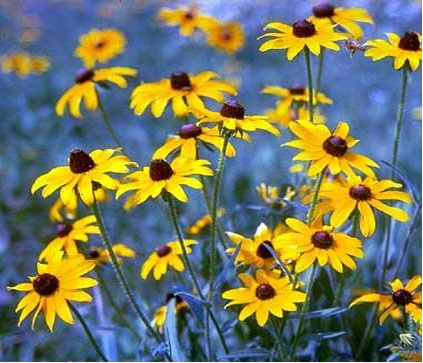Gardens of Memory
 Photo credit: Black-eyed Susans in field, photo by Martin van der Grintin@USDA-NRCS PLANTS database.
Photo credit: Black-eyed Susans in field, photo by Martin van der Grintin@USDA-NRCS PLANTS database.
The first image that flooded my mind for the novel that would eventually become The Cherokee Rose appeared unbidden. Several years ago when I was still in graduate school, I saw a young woman in my mind’s eye. She was walking through a field of flowers toward a large plantation house, missing the pageantry around her because of an unseen weight on her shoulders. That was all: a snapshot of a woman alone, slowly moving uphill through a field of beauty, but meeting resistance – an inner resistance – all along the way.
The theme of flowers and gardens blossomed as I developed The Cherokee Rose over a long period of time filled with interruptions. That woman I first saw became the character Ruth, whose memory of her mother is rooted in the southern garden. It was not until I began writing the story in earnest and, quite independently of that, when I started visiting the city of Detroit — that I learned about the practice of tending memory gardens. I picked up on this idea while hearing gardeners in the city talk about planting gardens in memory of loved ones who had moved as the city’s population began its steep decline. A friend might care for the old garden of someone who had moved away and left a vacant yard behind. A relative might transplant flowers from a departed loved one’s garden into her own, or a daughter might replicate the shape and colors of her mother’s previous plantings. Even if a loved one was long gone – perhaps off to a new city, or perhaps off to a place even farther away, like heaven or the deep, star-dusted universe, a plant would bloom in that person’s cherished memory. A plant would be the reminder of that loved one’s life and stories.
This beautiful notion of the memory garden grew on me and became an essential aspect of the experience of my characters in the novel. It has been wonderful to learn that readers who have spent time with the book are also moved by the notion of the memory garden. One reader, Kathleen Cargill, a researcher and gardener in the Upper Midwest, wrote me an email sharing her joy at realizing that she was keeping just such a garden but did not have a name or concept for it before. She told her daughters about the idea and says they all feel invigorated for their work in the yard this spring knowing that they have been keeping a memory garden all along.
As strange as it seems, it took reading this email for me to consciously realize that I keep a memory garden too. My grandmother was a fierce and artful gardener who grew vegetables for our meals as well as a plethora of colorful plants in her front, back, and skinny side yards. Before she passed away eleven years ago, she gave me some of her plantings: sunny yellow black-eyed Susans. I have carried a little patch of those same flowers across three households during my time in Ann Arbor. They are a bit of my grandmother’s passion, her peace, and her own memory of her former southern home, which I carry with me and continue to nurture.
This year, I am living in Montana, across the country from my Michigan home. As the weather turns from winter to the warm first kiss of spring, I am thinking about my garden, knowing that it will bloom in my absence, just as it has in my grandmother’s absence all these years.
Are you interested in starting a memory garden or reimaging a garden that you have already planted? Here are some images and ideas collected by others that brought color to my month of March. Here’s another great link for additional inspiration.
One Comment
William Young
I have been an avid fan of your work ever since I read the story of Doll. I can’t tell you how excited I am to read this.